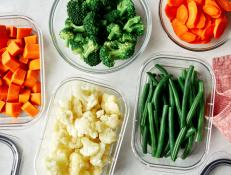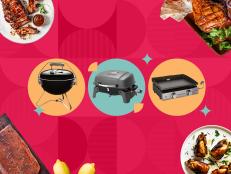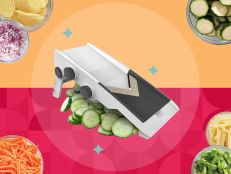How to Shop for Groceries When Everything Is More Expensive
With a few thoughtful strategies (and a trip down the frozen aisle) you can stretch your grocery budget even when things are tight.

Drazen Zigic/Getty
By Leah Brickley for Food Network Kitchen
Feeling the squeeze at checkout? You’re not alone. Even staples aren’t immune to inflation: the consumer price index for a dozen eggs is currently around $1.46 — compare that to $1.01 in 2021 and $1.00 in 2020 (only a penny less!). And it’s not just eggs; almost all food prices have risen this year, with cereals and baked goods leading the increases. So, what’s going on with our groceries? The answer is complicated — the pandemic, supply chain issues, climate change and the war in Ukraine are all contributors. There’s good news: despite all the frenzied buzz about food prices, it’s predicted that food-at-home (aka groceries) costs will rise only by 3 to 4 percent in 2022. But that’s on top of the inflation we all felt from the past two years. Here are tips for stretching and strengthening your dollars.
Download helpful grocery savings apps.
There are some money-saving apps designed specifically for grocery savings: Simply enter your zip code and Flipp will aggregate digital flyers from local participating stores — swipe through to find deals. Also, check if you live near a grocery chain that participates with Flashfood, the app that helps save money while also reducing food waste. Get notifications when perfectly good food items (everything from meat to cheese) are nearing their best before date and grab them up at a discount — up to 50%!
Stretch proteins instead of skipping them totally.
You’ll spend less money if you eat less meat, but it can be hard to totally do without the staples many families rely on and enjoy. If that’s you, keep meat but have it work harder with recipes that help a little go a long way — try these to start. Meat can play a supporting role in dishes like stir fries, grain bowls and soups, which are satisfyingly bulked up with veggies.
Buy private store brands.
Private label store brands are often less expensive than national brands and just as good (and in some cases identical). Grocery stores can produce their own private label foods (cutting out the middleman) or national brands sometimes bottle and jar your favorite products and simply repackage them as private. Be sure to compare prices before tossing into your cart.

Katrina Wittkamp/Getty
Fill up on frozen.
Have you noticed that the frozen food section is getting more interesting? There’s cauliflower rice and spiralized squash! Along with innovation, frozen food has managed to stay less expensive than fresh. But the real savings is in the storage — frozen keeps longer. If fresh vegetables and berries are too pricey then head to the freezer section. Use what you need without worrying about the rest spoiling. The same is true for meat — chicken and beef are particularly expensive right now. Look for frozen alternatives that will last longer and keep your money from going in the trash.
Planning your grocery list makes sense — but improvising can too.
Yes, we are fans of meal planning to make cooking efficient and ensure you don’t buy ingredients you can’t use before they spoil, but being an economical cook also means throwing together meals on the fly. Sometimes you need to use what you have on hand or buy what’s on sale and just make it work. The three unofficial rules to improvised cooking are 1) know a handful of essential and basic dishes 2) substitute ingredients with confidence 3) and add flourishes at the end — just like a chef in a restaurant. A drizzle of olive oil, sprinkle of salt, a spoonful of your favorite condiment or something crunchy and savory can make (and sometimes rescue) a finished dish.
Support local farmers and makers.
You don’t have to get all your groceries from a supermarket: there are farmers’ markets, CSA produce (and even seafood) shares, local bakeries, honey, eggs and meat (if you’re fortunate enough!). Investigate to see if some produce and other items may cost less than at the grocery store – the potential savings depends on your area, but you might be surprised what you find.
Sign up.
There are plenty of brick-and-mortar grocery memberships and online subscription services out there. With just a little investigation you may find that even with a yearly or monthly commitment there still may be savings. Some national grocery chains also include free delivery and gas perks, which would both be great right about now.
Related Links:






























































